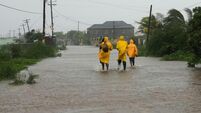Ozone threat to global warming bigger than thought
Ozone is a bigger contributor to global warming than previously thought, scientists said today.
A study found that mounting concentrations of ozone near the Earth’s surface as a result of vehicle pollution could damage plants and prevent them from absorbing carbon dioxide.
As a result carbon dioxide concentrations may build up in the atmosphere even more than expected, accelerating global warming, researchers said.
At the moment plants and soil are slowing-down global warming by storing around a quarter of CO2 released into the atmosphere by human activities.
As such plants act as an important carbon sink for the potent greenhouse gas.
A reduction in the carbon sink would increase the amount of CO2 that stays in the air.
Dr Stephen Stich, a Met Office climate change scientist and lead author of the new study which is published online in science journal Nature, said previous models had taken into account the potential benefits of global warming on plants but had not considered the negative effects.
“Climate models have largely ignored atmospheric chemistry but in this research we have identified a cause of potentially increased warming with elevated levels of surface ozone likely to suppress plant growth,” he said.
While ozone forms naturally in the atmosphere from other chemical compounds, the amount of ground-level ozone has been increasing due to the burning of fossil fuels.
Near-surface ozone has doubled since 1850 due to chemical emissions from vehicles, industrial processes and the burning of forests.
Although stratospheric ozone is beneficial because it filters the sun’s harmful rays, ground-level ozone can damage human health and cause respiratory problems as well as poisoning plants.
Co-author Professor Peter Cox, of the University of Exeter, said: “We estimate that ozone effects on plants could double the importance of ozone increases in the lower atmosphere as a driver of climate change, so policies to limit increases in near-surface ozone must be seen as an even higher priority.”
He said climate change and air quality were currently seen in isolation but the Government should deal with them together as measures to tackle one could intensify the other.
“Policies on climate change reduction and air quality are being considered in isolation. That means coming up with solutions to one that could exacerbate the other.
“We need to consider these issues in a more integrated way,” he said.













